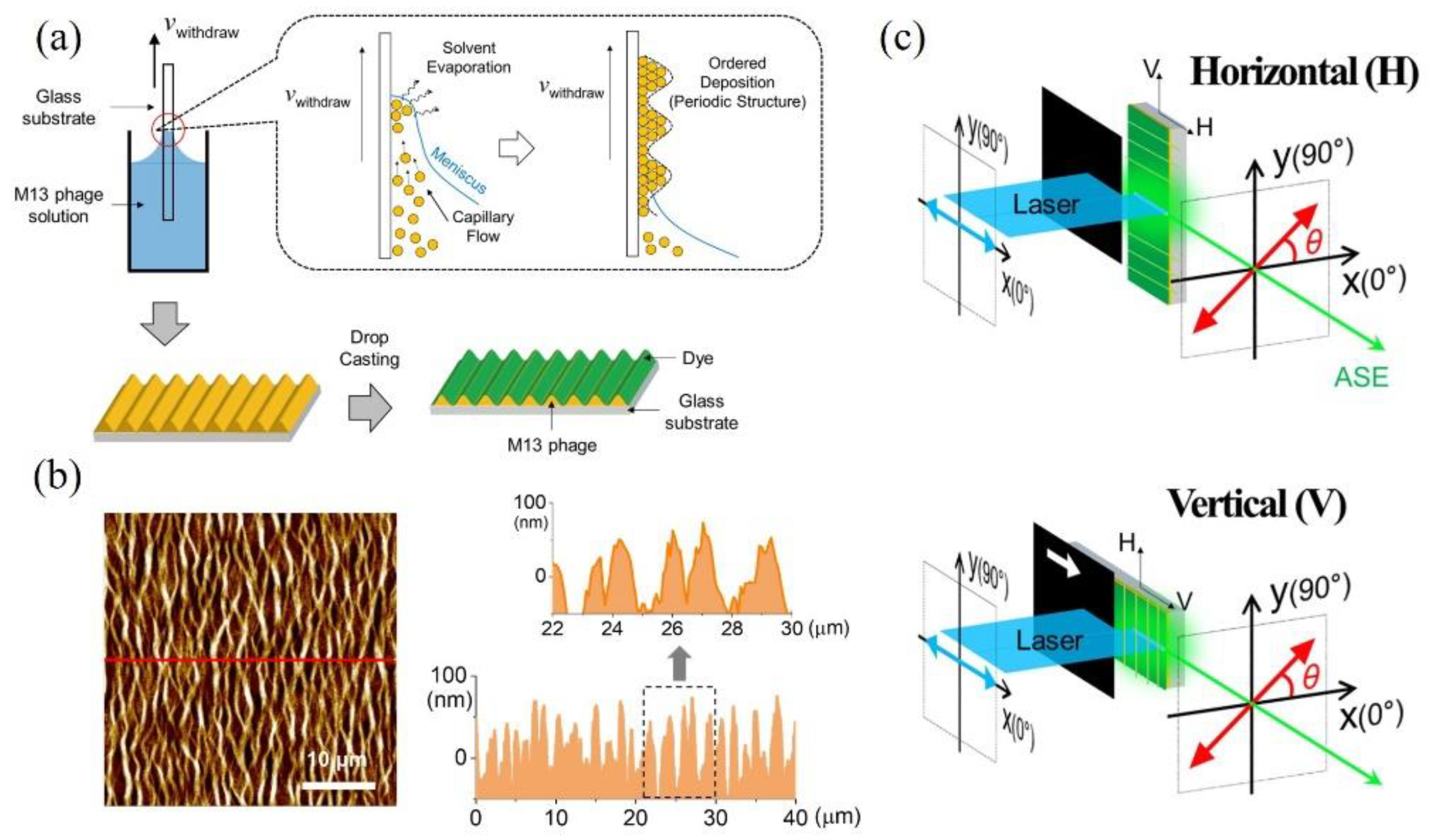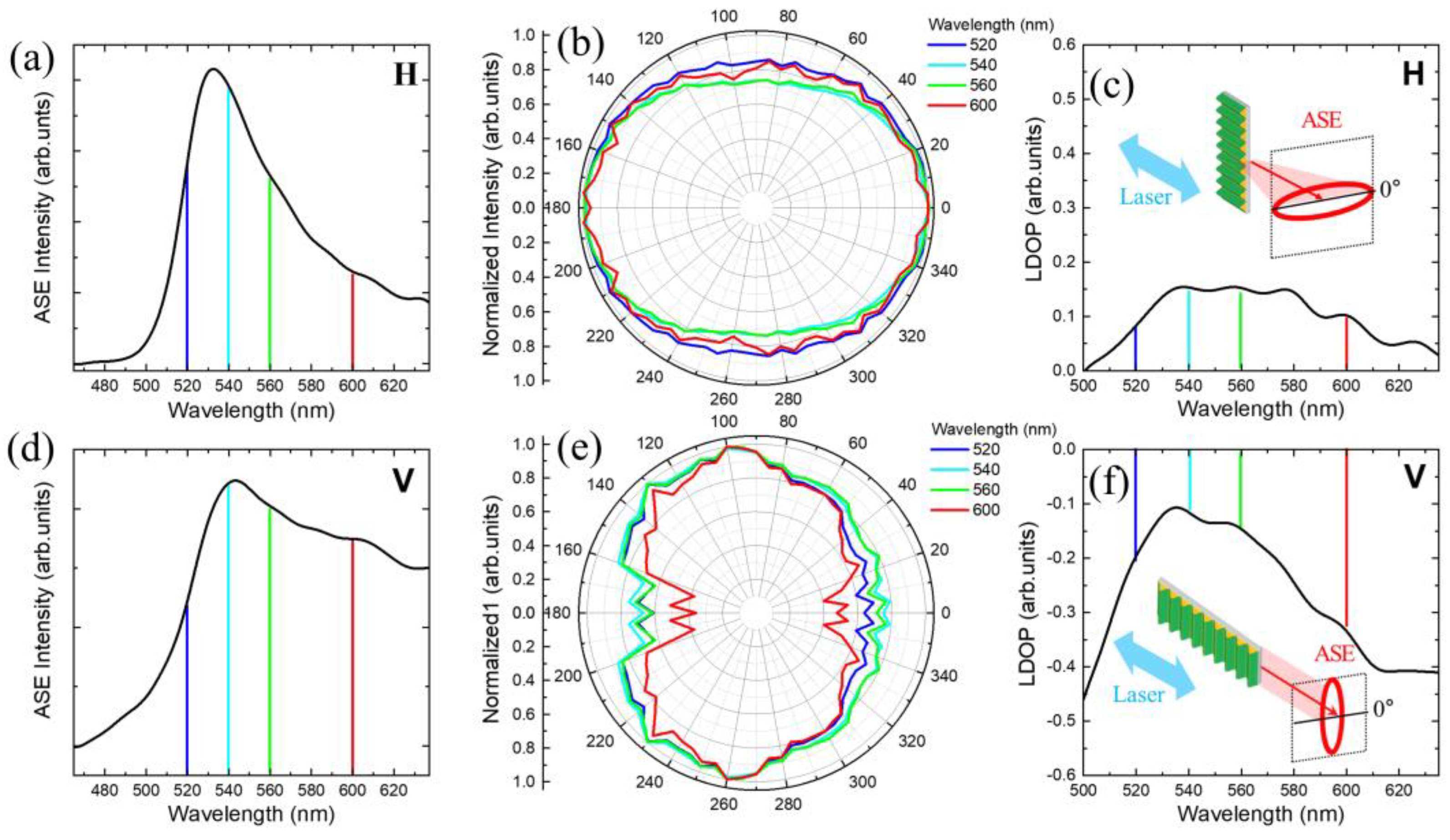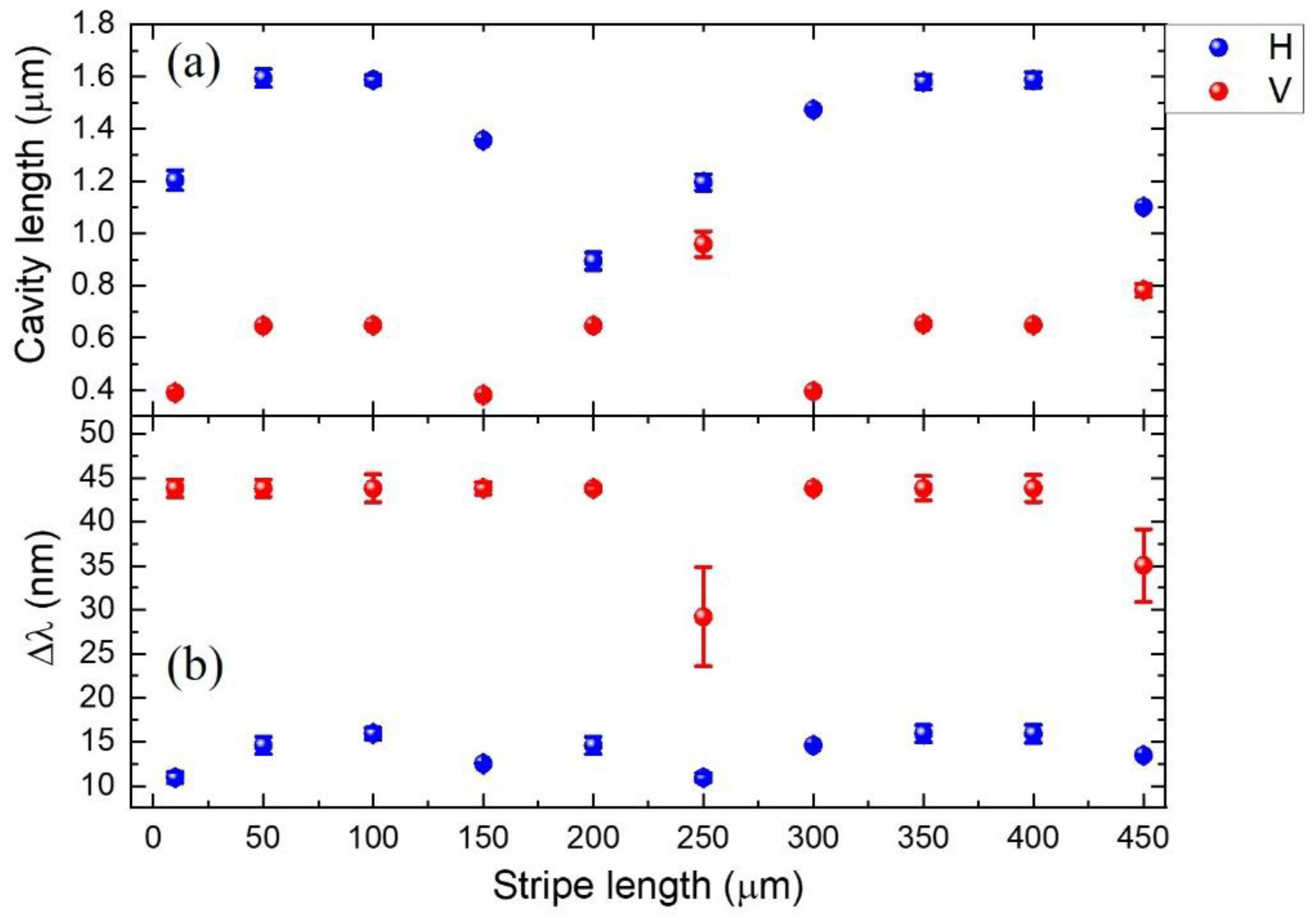Polarization Angle Dependence of Optical Gain in a Hybrid Structure of Alexa-Flour 488/M13 Bacteriophage
Abstract
1. Introduction
2. Materials and Methods
3. Results and Discussion
4. Conclusions
Supplementary Materials
Author Contributions
Funding
Institutional Review Board Statement
Informed Consent Statement
Data Availability Statement
Conflicts of Interest
References
- Fan, X.; Yun, S.H. The potential of optofluidic biolasers. Nat. Methods 2014, 11, 141–147. [Google Scholar] [CrossRef]
- Chen, Y.-C.; Fan, X. Biological lasers for biomedical applications. Adv. Opt. Mater. 2019, 7, 1900377. [Google Scholar] [CrossRef]
- Toropov, N.; Cabello, G.; Serrano, M.P.; Gutha, R.R.; Rafti, M.; Vollmer, F. Review of biosensing with whispering-gallery mode lasers. Light Sci. Appl. 2021, 10, 42. [Google Scholar] [CrossRef]
- Gather, M.C.; Yun, S.H. Single-cell biological lasers. Nat. Photonics 2011, 5, 406–410. [Google Scholar] [CrossRef]
- Gather, M.C.; Yun, S.H. Lasing from escherichia coli bacteria genetically programmed to express green fluorescent protein. Opt. Lett. 2011, 36, 3299–3301. [Google Scholar] [CrossRef] [PubMed]
- Hales, J.E.; Matmon, G.; Dalby, P.A.; Ward, J.M.; Aeppli, G. Virus laser for biological detection. Nat. Commun. 2019, 10, 3594. [Google Scholar] [CrossRef]
- Halperin-Sternfeld, M.; Ghosh, M.; Adler-Abramovich, L. Advantages of self-assembled supramolecular polymers toward biological applications. In Supramolecular Chemistry of Biomimetic Systems; Li, J., Ed.; Springer: Singapore, 2017; pp. 9–35. [Google Scholar]
- Lee, J.H.; Jin, H.-E.; Desai, M.S.; Ren, S.; Kim, S.; Lee, S.-W. Biomimetic sensor design. Nanoscale 2015, 7, 18379. [Google Scholar] [CrossRef]
- Mao, C.; Liu, A.; Cao, B. Virus-based chemical and biological sensing. Angew. Chem. Int. Ed. 2009, 48, 6790–6810. [Google Scholar] [CrossRef] [PubMed]
- Lee, B.Y.; Zhang, J.; Zueger, C.; Chung, W.-J.; Yoo, S.Y.; Wang, E.; Meyer, J.; Ramesh, R.; Lee, S.-W. Virus-based piezoelectric energy generation. Nat. Nanotechnol. 2012, 7, 351–356. [Google Scholar] [CrossRef] [PubMed]
- Nam, K.T.; Kim, D.-W.; Yoo, P.J.; Chiang, C.-Y.; Meethong, N.; Hammond, P.T.; Chiang, Y.-M.; Belchert, A.M. Virus-enabled synthesis and assembly of nanowires for lithium ion battery electrodes. Science 2016, 312, 885–888. [Google Scholar] [CrossRef] [PubMed]
- Dang, X.; Yi, H.; Ham, M.-H.; Qi, J.; Yun, D.S.; Ladewski, R.; Strano, M.S.; Hammond, P.T.; Belcher, A.M. Virus-templated self-assembled single-walled carbon nanotubes for highly efficient electron collection in photovoltaic devices. Nat. Nanotechnol. 2011, 6, 377–384. [Google Scholar] [CrossRef]
- Kim, W.-G.; Kim, K.; Ha, S.-H.; Song, H.; Yu, H.-W.; Kim, C.; Kim, J.-M.; Oh, J.-W. Virus based full colour pixels using a microheater. Sci. Rep. 2015, 5, 13757. [Google Scholar] [CrossRef] [PubMed]
- Chung, W.-J.; Oh, J.-W.; Kwak, K.; Lee, B.Y.; Meyer, J.; Wang, E.; Hexemer, A.; Lee, S.-W. Biomimetic self-templating supramolecular structures. Nature 2011, 478, 364–368. [Google Scholar] [CrossRef] [PubMed]
- Oh, J.-W.; Chung, W.-J.; Heo, K.; Jin, H.-E.; Lee, B.Y.; Wang, E.; Zueger, C.; Wong, W.; Meyer, J.; Kim, C.; et al. Biomimetic virus-based colourimetric sensors. Nat. Commun. 2014, 5, 3043. [Google Scholar] [CrossRef] [PubMed]
- Yoo, S.Y.; Chung, W.-J.; Kim, T.H.; Le, M.; Lee, S.-W. Facile patterning of genetically engineered M13 bacteriophage for directional growth of human fibroblast cells. Soft Matter 2011, 7, 363–368. [Google Scholar] [CrossRef]
- Yoo, S.Y.; Oh, J.-W.; Lee, S.-W. Phage-chips for novel optically readable tissue engineering assays. Langmuir 2012, 28, 2166–2172. [Google Scholar] [CrossRef][Green Version]
- Turitsyn, S.K.; Babin, S.A.; El-Taher, A.E.; Harper, P.; Churkin, D.V.; Kablukov, S.I.; Ania-Castañón, J.D.; Karalekas, V.; Podivilov, E.V. Random distributed feedback fibre laser. Nat. Photonics 2010, 4, 231–235. [Google Scholar] [CrossRef]
- Mahler, L.; Tredicucci, A.; Beltram, F.; Walther, C.; Faist, J.; Beere, H.E.; Ritchie, D.A.; Wiersma, D.S. Quasi-periodic distributed feedback laser. Nat. Photonics 2010, 4, 165–169. [Google Scholar] [CrossRef]
- Yuan, Z.; Zhou, Y.; Qiao, Z.; Aik, C.E.; Tu, W.-C.; Wu, X.; Chen, Y.-C. Stimulated chiral light-matter interactions in biological microlasers. ACS Nano 2021, 15, 8965–8975. [Google Scholar] [CrossRef]
- Yuan, Z.; Cheng, X.; Zhou, Y.; Tan, X.; Gong, X.; Rivy, H.; Gong, C.; Fan, X.; Wang, W.-J.; Chen, Y.-C. Distinguishing small molecules in microcavity with molecular laser polarization. ACS Photonics 2020, 7, 1908–1914. [Google Scholar] [CrossRef]
- Gozhyk, I.; Clavier, G.; Meallet-Renault, R.; Dvorko, M.; Pansu, R.; Audibert, J.-F.; Brosseau, A.; Lafargue, C.; Tsvirkun, V.; Lozenko, S.; et al. Polarization properties of solid-state organic lasers. Phys. Rev. A 2012, 86, 043817. [Google Scholar] [CrossRef]
- Gozhyk, I.; Boudreau, M.; Rabbani Haghighi, H.; Djellali, N.; Forget, S.; Chénais, S.; Ulysse, C.; Brosseau, A.; Pansu, R.; Audibert, J.-F.; et al. Gain properties of dye-doped polymer thin films. Phys. Rev. B 2015, 92, 214202. [Google Scholar] [CrossRef]
- Brinker, C.J. Dip coating. In Chemical Solution Deposition of Functional Oxide Thin Films; Schneller, T., Waser, R., Kosec, M., Payne, D., Eds.; Springer: Wien, Austria, 2013; pp. 233–261. [Google Scholar]
- Kim, B.J.; Kyhm, K. Optical modal gain saturation of exciton-exciton scattering and electron-hole plasma in ZnO. J. Korean Phys. Soc. 2007, 51, 1726–1731. [Google Scholar] [CrossRef]
- Jang, J.; Song, G.; Kyhm, K.; Cho, C.-H. Optical gain of inelastic exciton-exciton scattering in CdS nanowires. Appl. Phys. Lett. 2019, 114, 081101. [Google Scholar] [CrossRef]
- Jang, J.; Lee, S.; Kim, M.; Woo, S.; Kim, I.; Kyhm, J.; Song, J.; Taylor, R.A.; Kyhm, K. Excitation and temperature dependence of the broad gain spectrum in GaAs/AlGaAs quantum rings. Appl. Phys. Lett. 2020, 117, 213101. [Google Scholar] [CrossRef]
- Bagnall, D.M.; Chen, Y.F.; Zhu, Z.; Yao, T.; Koyama, S.; Shen, M.Y.; Goto, T. Optically pumped lasing of ZnO at room temperature. Appl. Phys. Lett. 1997, 70, 2230. [Google Scholar] [CrossRef]
- Monk, G.S. Light Principles and Experiments, 1st ed.; McGraw-Hill Book Company: New York, NY, USA; London, UK, 1937; pp. 376–380. [Google Scholar]




Publisher’s Note: MDPI stays neutral with regard to jurisdictional claims in published maps and institutional affiliations. |
© 2021 by the authors. Licensee MDPI, Basel, Switzerland. This article is an open access article distributed under the terms and conditions of the Creative Commons Attribution (CC BY) license (https://creativecommons.org/licenses/by/4.0/).
Share and Cite
Kim, I.; Jang, J.; Lee, S.; Kim, W.-G.; Oh, J.-W.; Wang, I.; Vial, J.-C.; Kyhm, K. Polarization Angle Dependence of Optical Gain in a Hybrid Structure of Alexa-Flour 488/M13 Bacteriophage. Nanomaterials 2021, 11, 3309. https://doi.org/10.3390/nano11123309
Kim I, Jang J, Lee S, Kim W-G, Oh J-W, Wang I, Vial J-C, Kyhm K. Polarization Angle Dependence of Optical Gain in a Hybrid Structure of Alexa-Flour 488/M13 Bacteriophage. Nanomaterials. 2021; 11(12):3309. https://doi.org/10.3390/nano11123309
Chicago/Turabian StyleKim, Inhong, Juyeong Jang, Seunghwan Lee, Won-Geun Kim, Jin-Woo Oh, Irène Wang, Jean-Claude Vial, and Kwangseuk Kyhm. 2021. "Polarization Angle Dependence of Optical Gain in a Hybrid Structure of Alexa-Flour 488/M13 Bacteriophage" Nanomaterials 11, no. 12: 3309. https://doi.org/10.3390/nano11123309
APA StyleKim, I., Jang, J., Lee, S., Kim, W.-G., Oh, J.-W., Wang, I., Vial, J.-C., & Kyhm, K. (2021). Polarization Angle Dependence of Optical Gain in a Hybrid Structure of Alexa-Flour 488/M13 Bacteriophage. Nanomaterials, 11(12), 3309. https://doi.org/10.3390/nano11123309






